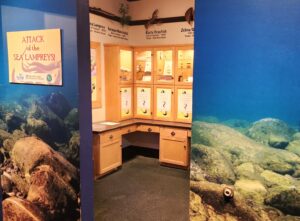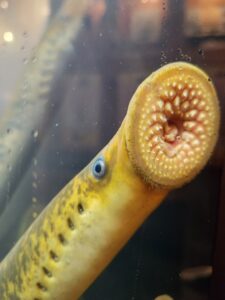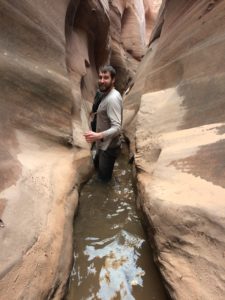New exhibit at Wisconsin Maritime Museum showcases history and management of sea lamprey in the Great Lakes
Visitors to the Wisconsin Maritime Museum in Manitowoc can now get up close and personal with one of the Great Lake’s most infamous invasive fish, the sea lamprey. The new exhibit, entitled “Attack of the Sea Lampreys,” was made possible through a collaboration between Wisconsin Sea Grant and the Great Lakes Fishery Commission and tells the story of how sea lamprey were introduced to the Great Lakes, their impact and the ongoing efforts to manage them.

The entrance to “Attack of the Sea Lampreys,” a new exhibit at the Wisconsin Maritime Museum. Photo: Kevin Cullen
Chief curator Kevin Cullen and the education team revamped an invasive species lab on the museum’s lower level to house the new exhibit. The space was largely dormant and full of locked cabinets. Said Cullen, “People would just pass by it, so it became a really good opportunity to enhance a space that was already there.”
The redesigned space provides a more interactive, sensory experience. Visitors can now open the cabinet doors to find answers to questions about sea lamprey, such as how many eggs they lay or bones they have. Content is written at a middle-school reading level, and many items are meant to be touched and handled, making the exhibit ideal for kids and families.
The irrefutable stars of the show, however, are the lamprey. Thanks to support and a custom-built tank from the Great Lakes Fishery Commission, museum-goers can enjoy watching over a dozen lamprey hanging out, their toothy maws suctioned to the side of the glass.
Cullen said initial feedback has been positive. “[Visitors] love it. I think they’re creeped out by these things and fascinated to see them.”
The creep factor is due largely to how sea lamprey feed. A parasitic fish, sea lamprey latch onto larger fish and suck out blood and body fluids. Their mouths are disc-shaped and ringed with rows of horned teeth to better grab flesh. Once suctioned onto a host, sea lamprey then use their sharp tongue to bore a hole in the fish, usually near its heart. A single lamprey can kill up to 40 pounds of fish.

A sea lamprey suctions its mouth onto the walls of a glass tank at the Wisconsin Maritime Museum. Photo: Kevin Cullen
For many, the story of sea lamprey is the stuff of nightmares—or at least a low-budget horror film. Titus Seilheimer, the fisheries specialist with Wisconsin Sea Grant who helped the museum secure the lamprey tank, hopes the exhibit helps visitors see another story.
“It’s one of the great success stories of invasive species management,” said Seilheimer.
Originally from the Atlantic Ocean, sea lamprey arrived in the Great Lakes via shipping canals, landing in Lakes Michigan and Superior by the 1930s and 1940s. By the mid-twentieth century, the lamprey population exploded, devastating the Great Lakes fishery and ecosystem. It wasn’t until the discovery of TFM, a chemical that selectively kills lamprey, that numbers decreased.
The population of sea lamprey is now 90% lower than what it was at its peak. But because lamprey can lay up to 100,000 eggs, that success is tenuous. Said Seilheimer, “If you take your foot off the gas, you see lamprey numbers increase.” Continuous management is required to keep the population in check.
The exhibit is a reminder of how humans have shaped and continue to shape the Great Lakes ecosystem. Said Cullen, “I hope [visitors] have a sense of responsibility when they leave that how they behave in the Great Lakes basin affects others.”
“Attack of the Sea Lampreys” at the Wisconsin Maritime Museum is now open to the public.
The post New exhibit at Wisconsin Maritime Museum showcases history and management of sea lamprey in the Great Lakes first appeared on Wisconsin Sea Grant.News Releases | Wisconsin Sea Grant
News Releases | Wisconsin Sea Grant
https://www.seagrant.wisc.edu/news/new-exhibit-at-wisconsin-maritime-museum-showcases-history-and-management-of-sea-lamprey-in-the-great-lakes/?utm_source=rss&utm_medium=rss&utm_campaign=new-exhibit-at-wisconsin-maritime-museum-showcases-history-and-management-of-sea-lamprey-in-the-great-lakes


